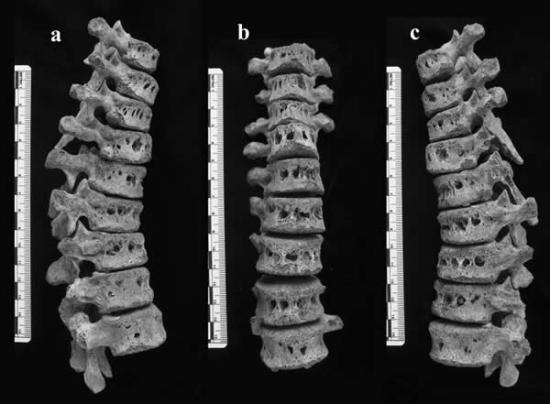
被布氏杆菌侵蚀的椎骨
美国密西根州立大学(Michigan State University)的两个研究组通过现代科技手段证实阿尔巴尼亚中世纪时期曾盛行布氏杆菌病(brucellosis),这种传染病现今仍流行于地中海及其他一些地区,主要症状是发烧和慢性呼吸系统疾病,患者通过接触携带布氏杆菌的牲畜或食用受感染的肉类和未经消毒的奶制品而得病。
科研工作分两个小组,一个工作在阿尔巴尼亚(Albania)的一个中世纪(约476年~1453年)埋葬点,另一个在美国密西根州中南部城市东兰辛(East Lansing)的法医实验室。人类学家T. Fenton带领的研究组工作对埋葬点挖掘出的人类遗骸建立生物学特征档案(包括性别、年龄、骨骼病理和健康史)的过程中发现了两个十世纪到十三世纪的青年男性身上的椎骨存在严重的损伤。他们猜想这两个男孩可能得了肺结核(tuberculosis),并将一些骨骼样本送到东兰辛的法医实验室。法医学家D. Foran和他的研究团队从骨头上取出少量样本,提取DNA,从中寻找可能的病原菌DNA。结果对能引起肺结核的细菌检测为阴性。
Fenton的研究组认为导致骨头损伤的可能是另一种病原菌——布氏杆菌。布氏杆菌病和肺结核病能对骨头造成相似的破坏——吃掉骨头,但还从没有人从考古点的人类骨骼中发现有布氏杆菌。
Foran的研究组开发出另一套用于检测布氏杆菌的方法,重新实验。这次的结果返回为阳性。
“这是好奇心、坚持和协同作战三者结合产生的成果,”Foran说,“通过异地、跨学科的合作能发现一千年前的秘密着实令人兴奋。”

 Osteological and molecular identification of brucellosis in ancient Butrint, Albania
Osteological and molecular identification of brucellosis in ancient Butrint, Albania
Michael J. Mutolo, Lindsey L. Jenny, Amanda R. Buszek, Todd W. Fenton, David R. Foran
Ancient skeletal remains can harbor unique information about past civilizations at both the morphological and molecular levels. For instance, a number of diseases manifest in bone, some of which have been confirmed through DNA analysis, verifying their presence in ancient populations. In this study, anthropological analysis of skeletal remains from the ancient Albanian city of Butrint identified individuals with severe circular lytic lesions on their thoracic and lumbar vertebrae. Differential diagnosis suggested that the lesions resulted from pathologies known to affect these skeletal regions, such as tuberculosis (TB) or brucellosis. Relevant bones of two adolescent males from the 10th to 13th century AD that displayed the lesions, along with unaffected individuals, were collected in the field. Genetic screening of the skeletal samples for TB was repeatedly negative, thus additional testing for Brucella spp.—bacteria of livestock and the causative agent of brucellosis in humans—was conducted. Two Brucella DNA markers, the IS6501 insertion element and Bcsp31 gene, amplified from the affected vertebrae and/or ribs, whereas all unaffected individuals and control samples were negative. Subsequent DNA sequencing confirmed the presence of the brucellar IS6501 insertion element. On the basis of the skeletal lesions, negative tests for TB, and positive Brucella findings, we report a confirmed occurrence of brucellosis in archaeologically recovered human bone. These findings suggest that brucellosis has been endemic to the area since at least the Middle Ages.
文献链接:https://onlinelibrary.wiley.com/doi/10.1002/ajpa.21643/abstract







